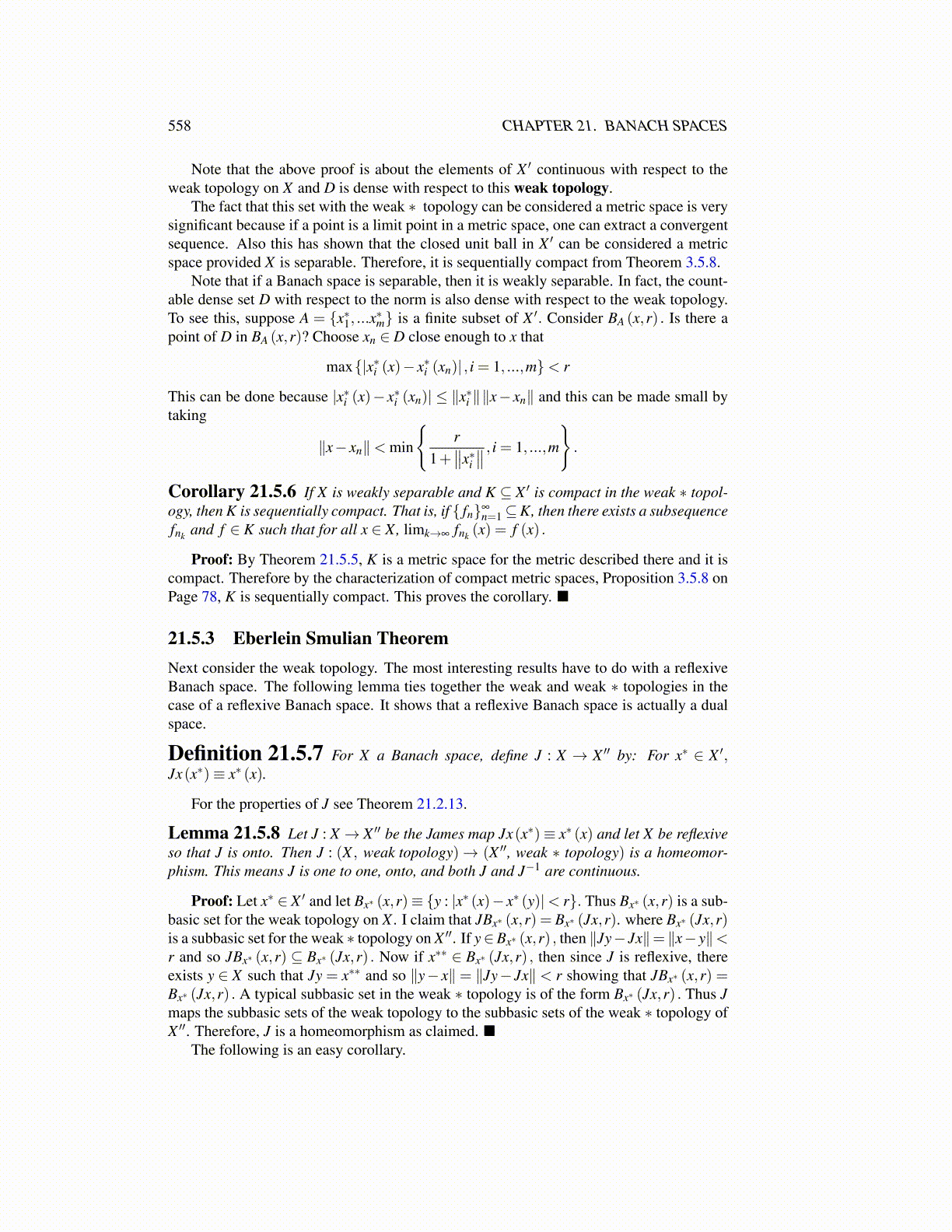
558 CHAPTER 21. BANACH SPACES
Note that the above proof is about the elements of X ′ continuous with respect to theweak topology on X and D is dense with respect to this weak topology.
The fact that this set with the weak ∗ topology can be considered a metric space is verysignificant because if a point is a limit point in a metric space, one can extract a convergentsequence. Also this has shown that the closed unit ball in X ′ can be considered a metricspace provided X is separable. Therefore, it is sequentially compact from Theorem 3.5.8.
Note that if a Banach space is separable, then it is weakly separable. In fact, the count-able dense set D with respect to the norm is also dense with respect to the weak topology.To see this, suppose A = {x∗1, ...x∗m} is a finite subset of X ′. Consider BA (x,r) . Is there apoint of D in BA (x,r)? Choose xn ∈ D close enough to x that
max{|x∗i (x)− x∗i (xn)| , i = 1, ...,m}< r
This can be done because |x∗i (x)− x∗i (xn)| ≤ ∥x∗i ∥∥x− xn∥ and this can be made small bytaking
∥x− xn∥< min
{r
1+∥∥x∗i∥∥ , i = 1, ...,m
}.
Corollary 21.5.6 If X is weakly separable and K ⊆ X ′ is compact in the weak ∗ topol-ogy, then K is sequentially compact. That is, if { fn}∞
n=1⊆K, then there exists a subsequencefnk and f ∈ K such that for all x ∈ X, limk→∞ fnk (x) = f (x) .
Proof: By Theorem 21.5.5, K is a metric space for the metric described there and it iscompact. Therefore by the characterization of compact metric spaces, Proposition 3.5.8 onPage 78, K is sequentially compact. This proves the corollary. ■
21.5.3 Eberlein Smulian TheoremNext consider the weak topology. The most interesting results have to do with a reflexiveBanach space. The following lemma ties together the weak and weak ∗ topologies in thecase of a reflexive Banach space. It shows that a reflexive Banach space is actually a dualspace.
Definition 21.5.7 For X a Banach space, define J : X → X ′′ by: For x∗ ∈ X ′,Jx(x∗)≡ x∗ (x).
For the properties of J see Theorem 21.2.13.
Lemma 21.5.8 Let J : X → X ′′ be the James map Jx(x∗)≡ x∗ (x) and let X be reflexiveso that J is onto. Then J : (X , weak topology)→ (X ′′, weak ∗ topology) is a homeomor-phism. This means J is one to one, onto, and both J and J−1 are continuous.
Proof: Let x∗ ∈ X ′ and let Bx∗ (x,r)≡ {y : |x∗ (x)− x∗ (y)|< r}. Thus Bx∗ (x,r) is a sub-basic set for the weak topology on X . I claim that JBx∗ (x,r) = Bx∗ (Jx,r). where Bx∗ (Jx,r)is a subbasic set for the weak ∗ topology on X ′′. If y∈Bx∗ (x,r) , then ∥Jy− Jx∥= ∥x− y∥<r and so JBx∗ (x,r) ⊆ Bx∗ (Jx,r) . Now if x∗∗ ∈ Bx∗ (Jx,r) , then since J is reflexive, thereexists y ∈ X such that Jy = x∗∗ and so ∥y− x∥ = ∥Jy− Jx∥ < r showing that JBx∗ (x,r) =Bx∗ (Jx,r) . A typical subbasic set in the weak ∗ topology is of the form Bx∗ (Jx,r) . Thus Jmaps the subbasic sets of the weak topology to the subbasic sets of the weak ∗ topology ofX ′′. Therefore, J is a homeomorphism as claimed. ■
The following is an easy corollary.